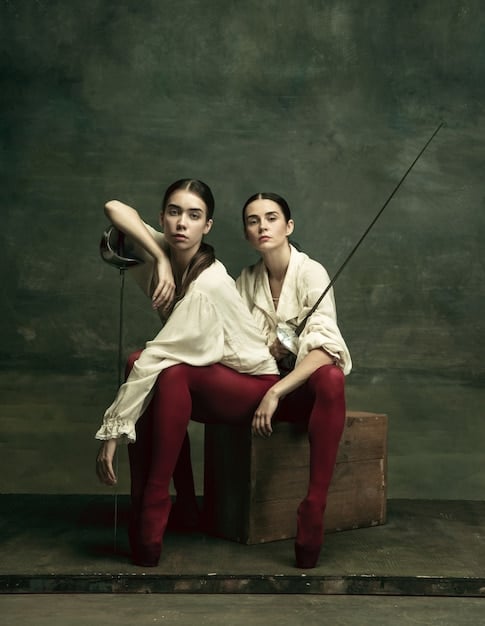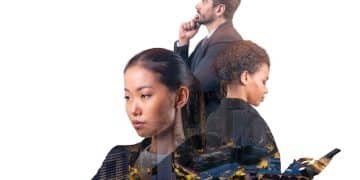Korean Dramas: Exploring Evolving Gender Roles of Women

Anúncios
Korean dramas are increasingly portraying women in diverse and empowered roles, challenging traditional gender stereotypes while exploring career ambitions, complex relationships, and societal expectations, thereby reflecting and influencing cultural shifts in gender perspectives.
Anúncios
Korean dramas, or K-dramas, have captivated global audiences with their compelling narratives, high production values, and attractive stars. However, beyond the romance and melodrama lies a fascinating exploration of **Korean Dramas and Gender Roles: Examining the Portrayal of Women in Modern Series**. Examining how female characters have evolved in these series provides insights into changing societal attitudes towards women in Korea and beyond.
The Historical Context of Women in Korean Society
Understanding the portrayal of women in modern K-dramas requires a brief look at Korean history. Traditional Korean society was heavily influenced by Confucianism, which emphasized hierarchical relationships and prescribed specific roles for men and women.
Anúncios
Confucian Influence on Gender Roles
Confucian ideals placed women primarily in the domestic sphere, responsible for household duties and raising children. Virtues such as obedience, modesty, and self-sacrifice were highly valued in women, reinforcing their subordination to men.
These traditional gender roles were deeply ingrained in Korean society for centuries, impacting women’s access to education, employment, and political participation. While legal and social reforms have significantly improved women’s rights in recent decades, the legacy of Confucianism continues to shape perceptions and expectations.

The Impact of Modernization and Westernization
The 20th century brought rapid modernization and Westernization to Korea, leading to significant social and cultural changes. Increased access to education and employment opportunities empowered women to challenge traditional gender roles and pursue their own aspirations. However, these changes were not without their challenges.
- Exposure to new lifestyles
- Greater economic independence
- New outlook on marriage
Many women found themselves navigating the conflict between traditional expectations and modern desires, struggling to balance career ambitions with family responsibilities. This tension is often reflected in the complex and nuanced portrayals of female characters in K-dramas.
In this way, K-dramas sometimes portray both the struggles and triumphs of women navigating a transformed culture. While reflecting broader trends, they often offer a vision for a more inclusive future.
Early K-Dramas and the Damsel in Distress Trope
In the early days of K-dramas, female characters were often relegated to stereotypical roles. The “damsel in distress” was a common archetype, portraying women as passive, helpless, and dependent on male protagonists for rescue and validation.
Characteristics of the Early Female Protagonist
These early female characters often lacked agency and were primarily defined by their relationships with men. Their storylines typically revolved around romance and marriage, with little emphasis on their individual goals or aspirations.
Examples include the sweet, innocent, but ultimately weak characters portrayed in dramas of the late 90s and early 2000s. These characters were often from poor backgrounds, facing financial hardship, and dreaming of a fairy-tale marriage to a wealthy and powerful man.
Limitations of this Portrayal
This limited portrayal of women reinforced traditional gender stereotypes and perpetuated the notion that women’s worth is primarily determined by their physical appearance and their ability to attract a male partner. It also failed to reflect the diverse experiences and aspirations of real women in Korean society.
- Reinforced harmful gender stereotypes and expectations.
- Limited the scope of female characters’ storylines.
- Did not reflect the experiences of independent women.
Moreover, these portrayals often glossed over the very real challenges women faced in Korean society, from workplace discrimination to lack of representation in politics.
As K-dramas began to evolve, however, so too did the roles for women within them. New writers and directors started pushing back against some of these limiting portrayals, opening the door for a new generation of female characters.
The Rise of Independent and Career-Oriented Women
One of the most significant developments in recent years has been the emergence of independent and career-oriented female characters in K-dramas. These women are ambitious, intelligent, and assertive, pursuing successful careers in traditionally male-dominated fields.
Examples of Female Empowerment in K-Dramas
Dramas like “Search: WWW” feature strong female leads who excel in the competitive world of IT companies, challenging gender biases and stereotypes. These characters are not afraid to assert their opinions, take risks, and prioritize their professional goals.
In medical dramas like “Dr. Romantic,” female doctors are portrayed as skilled, compassionate, and dedicated to their patients, often facing discrimination and prejudice but persevering through their talent and determination. Similarly, legal dramas like “Lawless Lawyer” showcase female lawyers who are fiercely independent and willing to fight for justice, even in the face of corruption and danger.
Impact on Audience Perceptions
The portrayal of independent and career-oriented women in K-dramas has had a significant impact on audience perceptions. It challenges traditional notions of femininity and encourages viewers to see women as capable, competent, and deserving of equal opportunities.
- Challenging traditional norms to consider new models.
- Expanding perceptions and views of leadership.
- Highlighting that women can be in any professional role.
These characters serve as role models for young women, inspiring them to pursue their dreams and break through societal barriers. They also promote a more nuanced and realistic representation of women in the workplace, acknowledging the challenges and sacrifices that often come with success.
By showing women taking charge of their lives and careers, these dramas help challenge stereotypes about the types of positions and behaviors appropriate for women. It’s a significant step in normalizing female ambition in the cultural sphere.
Challenging Traditional Relationship Dynamics
K-dramas are also increasingly challenging traditional relationship dynamics, moving away from the one-sided, male-dominated romances of the past. Modern series often feature more equal partnerships, where both partners respect each other’s opinions, value their individual identities, and share responsibilities.
The Evolving Portrayal of Romance
In dramas like “Something in the Rain,” the female lead is an independent career woman who engages in a relationship with a younger man. The series explores the challenges of navigating age differences and societal expectations, while also showcasing the importance of mutual respect, open communication, and emotional intimacy.
Other dramas, like “Be Melodramatic,” portray a group of female friends navigating the ups and downs of relationships, careers, and personal growth. The series emphasizes the importance of female solidarity and the power of women supporting each other through difficult times.
Re-evaluating Marriage and Family
Modern K-dramas are also re-evaluating traditional notions of marriage and family, exploring alternative models and challenging societal pressures to conform to conventional expectations. Some series focus on single women choosing to prioritize their careers and personal fulfillment over marriage, while others explore the challenges and rewards of non-traditional family structures.
- Marriage is not required for women to succeed.
- Shows are more inclusive of different ideas and views.
- Focusing on personal growth.
These dramas provide a platform for discussing important social issues, such as the declining marriage rate in Korea and the increasing number of women choosing to remain single. They also offer a more realistic and diverse representation of modern relationships, acknowledging that there is no one-size-fits-all approach to love and family.
These examples start necessary discussions about love, life, and happiness which can help drive societal changes.
The Impact of Female Writers and Directors
The growing presence of female writers and directors in the K-drama industry has played a crucial role in shaping the portrayal of women. These creatives bring their unique perspectives and experiences to the table, contributing to more nuanced, authentic, and empowering representations of female characters.
The Female Gaze in Storytelling
Female writers and directors are more likely to challenge traditional gender stereotypes and create complex, multi-dimensional female characters who are not simply defined by their relationships with men. They also tend to focus on issues that are important to women, such as workplace discrimination, gender inequality, and the pressure to balance career and family.
By telling stories from a female perspective, these creatives offer a fresh and insightful look at the lives of women in Korean society. They also provide a platform for female actors to showcase their talents and challenge traditional notions of beauty and femininity.
Promoting Diversity and Inclusion
The increasing number of female writers and directors in the K-drama industry is also promoting greater diversity and inclusion. These creatives are more likely to cast women in leading roles, create storylines that reflect the experiences of marginalized groups, and challenge societal norms and prejudices.
- Stories that feature diverse perspectives.
- Women in leading roles.
- Challenging biases.
By amplifying the voices of women and underrepresented groups, these dramas contribute to a more inclusive and equitable society. They also encourage viewers to question their own biases and assumptions, fostering greater empathy and understanding.
The impact of these writers and directors is impossible to overstate, and a driving force for the portrayal of women in K-dramas.
Future Trends and Challenges
While significant progress has been made in recent years, there are still challenges to overcome and areas where further improvement is needed regarding the portrayal of women in K-dramas. One ongoing issue is the persistence of certain stereotypes, such as the “candy girl” archetype, which portrays women as overly optimistic, naïve, and dependent on male protection.
Moving Beyond Stereotypes
Another challenge is the lack of diversity in female representation. While there has been an increase in the number of independent and career-oriented female characters, many of these women are still depicted as conventionally attractive and affluent.
It is important for K-dramas to move beyond these limited portrayals and showcase a wider range of female experiences, including those of women from different socioeconomic backgrounds, ethnicities, and sexual orientations. This will require greater efforts to promote diversity and inclusion both on and off screen.
Addressing Social Issues
Looking ahead, there is a growing opportunity for K-dramas to address important social issues related to gender inequality and women’s rights. Series can tackle topics such as sexual harassment, domestic violence, and the gender pay gap, raising awareness and sparking conversations about these critical issues.
- Raise awareness for important cultural events.
- Tackling inequalities across the world.
- Shining a light on the gender pay gap.
By using their platform to promote social change, K-dramas can play a positive role in shaping attitudes and behaviors. They can also inspire viewers to take action and challenge injustice in their own communities.
The future looks bright with continued progress and momentum in this area. As long as these trends are maintained, change is likely.
| Key Point | Brief Description |
|---|---|
| 🎬 Evolving Roles | From damsels to independent career women, roles are diversifying. |
| 👩💻 Career Focus | More dramas now showcase women in leading professional fields. |
| ❤️ Relationships | Exploring equality and challenges to traditional dynamics. |
| ✍️ Creators | Female writers/directors driving nuanced and empowering content. |
Frequently Asked Questions
▼
Historically, women were frequently portrayed as damsels in distress or adhering to traditional roles emphasizing domesticity and submissiveness. This often reinforced conventional gender expectations prevalent in Korean culture.
▼
Modern K-dramas like “Search: WWW” and “Mine” showcase women in powerful, professional roles who defy stereotypes and challenge traditional expectations regarding career and personal ambition.
▼
Female writers and directors often bring nuanced perspectives to storytelling, creating more complex characters and addressing issues pertinent to women, promoting diversity and challenging conventional representations.
▼
Challenges persist, including the persistence of stereotypes like the “candy girl” archetype and the limited diversity in female representation, which can reinforce unrealistic standards of beauty and success.
▼
K-dramas are increasingly fostering conversations about gender equality by presenting characters that challenge traditional norms and depict women in varied, assertive, and leading roles, influencing societal views.
Conclusion
The portrayal of women in K-dramas has undergone a significant transformation, moving away from stereotypical roles towards more complex, independent, and empowered characters. While challenges remain, the increasing presence of female writers and directors, coupled with a growing awareness of social issues, suggests that K-dramas will continue to play a vital role in promoting gender equality and challenging traditional norms in the future.





